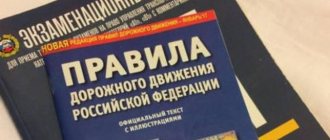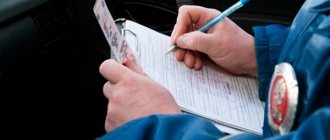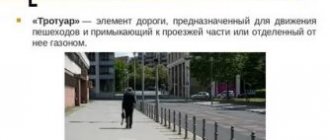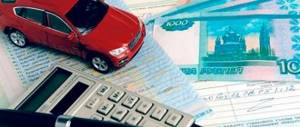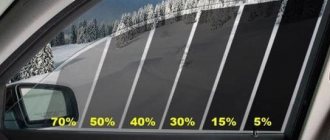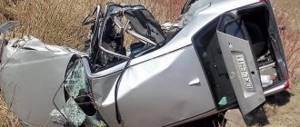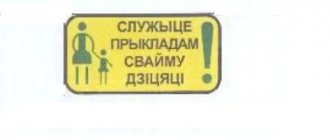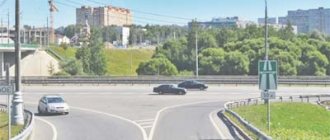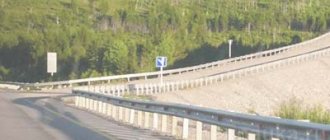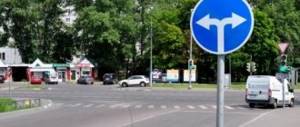Cycling is a popular sport, however, to preserve personal safety, it is necessary to use this type of transport only in designated areas.
Special places where you can travel on such a vehicle have a “cycle path sign”. This designation means that cycling and other types of transport are prohibited on this section of the road.
What does the bike lane sign mean?
Externally, the sign looks like a white bicycle, which is placed on a blue background; the sign itself is round.
This designation means that the area is intended for riding two-wheeled vehicles, while the following features must be observed for other road users:
- vehicles must not cross the zone and use the roadway as a parking space;
- Pedestrians should not travel in the bicycle zone. An exception may be the fact that there is no sidewalk, but the pedestrian must not interfere with the movement of the bicycle.
This type of road is intended for traveling on two-wheelers and scooters.
The main purpose of the bike path is:
- complete safety of travel participants;
- reducing the occurrence of accidents on the roads.
Let's celebrate! Recently, the number of such equipped places for cycling has been growing rapidly. In European countries, the presence of bicycle roads is mandatory, since a large number of residents travel by this type of transport.
What does a bike lane sign look like?
Fines for bike lanes
In the territory marked with the symbol 4.4.1, you can only drive a non-mechanical vehicle, as well as a moped or scooter. Cars have nothing to do there. But drivers often ignore the ban. Violators face Part 2 of Article 12.15 of the Administrative Code:
Driving on bicycle or pedestrian paths or sidewalks in violation of the Traffic Rules entails an administrative fine of two thousand rubles.
Stopping and parking in the zone of influence of 4.4.1 is also prohibited by one of the provisions of paragraph 12.4 of the traffic rules. For these actions, the car driver will receive a fine of 500 rubles. in accordance with Part 1 of Article 12.19 of the Code. And in both cases, the traffic police officer has the right to apply Part 1 of Article 12.16 of the Code of Administrative Offenses (ignoring the requirements of signs and markings), that is, to demand payment of another 500 rubles.
More on AutoLex.Net:
Correct parking in reverse
Theoretically, a pedestrian can also be punished for using a bicycle path. After all, this category of traffic participants has the right to move in the zone of influence of symbol 4.4.1 only in the absence of a sidewalk. Pedestrians should stay to the right and not interfere with cyclists.
Otherwise, you can run into a fine of 500 rubles. according to Part 1 of Art. 12.29 Code of Administrative Offenses or a warning from a traffic police inspector. This, of course, does not mean that the driver of a non-motorized vehicle or moped can hit a pedestrian with impunity.
The “Bicycle path” sign is still rarely seen in Russia. And it causes bewilderment among many motorists, and some completely neglect it. And in vain, because the number of cyclists is growing every year. This means that the number of separate lanes and separate zones for them will also increase.
Types of sign
Depending on the type of road on which cycling occurs, the signs may have distinctive features.
Tracks can be of various types:
One-way – designed for cyclists to ride in one direction; this type of route has the following features:
- are marked with a special sign;
- has a slight elevation from other movement areas;
- separated from roads by a special buffer zone.
Two-way – cyclists can travel in different directions. Most often they are located in places with a large number of attractions. Also very often this type of road can be found on embankments.
Combined - this type most often adjoins sidewalks and is located at a distance from the highway.
Isolated - designed not only for movement on two-wheeled vehicles, but also for pedestrians.
Good to know! Each type of road must be marked with a corresponding sign at the beginning of the coverage area and at its end, thereby notifying cyclists of the end of the bicycle road.
Who else may be in the track area?
The movement of vehicles along alleys marked with sign 4.5.1 is strictly prohibited. Temporary stopping and parking of cars is also impossible. Cyclists are also not allowed to ride in this zone.
And yet, traffic rules allow exceptions in some cases. Here's who can enter the pedestrian zone:
- An adult cyclist, if he does not have the opportunity to ride on a bicycle path, shoulder or right edge of the road.
- A cyclist over 14 years of age accompanying a child under 14 years of age riding a bicycle or carrying a child under 7 years of age on a booster seat.
- Vehicles for road maintenance and municipal services.
- Vehicles with cargo intended for trade and other enterprises located in the sign area.
- the structure where the car is heading must be located directly on the side of the pedestrian zone, otherwise you will have to look for another route;
- the driver is obliged to choose the shortest route to the destination;
- there must be no other access possibilities;
- The driver must ensure a safe environment.
Otherwise, for violating traffic rules, you will be fined in the amount of two thousand rubles - Art. 12.15 Code of Administrative Offences.
There are motorists who, in order to avoid punishment, complain in court about the non-compliance of the sign with GOST or the inconspicuousness of the pedestrian path due to increased snow cover, but this will not convince strict judges - for violating traffic rules you will have to pay in rubles (Decree of the Moscow Regional Court of 2013) .
Interesting fact. There are no bicycle or pedestrian paths on the Crimean Bridge - this is the federal highway A-290. There are also no stopping areas. If a cyclist can cross the bridge, then only by observing traffic rules, that is, he will pedal the entire 19 kilometers without stopping.
Watch this video on YouTube
Where the sign is installed, its coverage area
This designation can be found in the following places:
- to the right of the marked traffic zone, separated from the sidewalk or roadway by curbs or grass;
- over an area that looks like a marked road on the right side of the roadway. Additionally, it must be established about.
This type of marking can be found in parks and plaza areas. In big cities, bicycle paths are also located in the city center for convenient travel.
The effect of such a designation begins directly in the place where the corresponding mark is placed. If there is an intersection or a turn on the path, after crossing which there is no sign, this means that the zone is over for cycling.
For those roadways where there is no “Bicycle Path” designation, but a bicycle is painted on the asphalt, this means that not only cyclists, but also cars can move along the designated area.
Note! The end of a two-wheeler trail must be marked with a sign showing a bicycle on a blue background, with a red line through it.
Liability for violation of sign 3.9
Liability for violating the sign that bicycles are prohibited is directly enshrined in administrative legislation.
So, according to Part 1 of Art. 12.16 of the Code of Administrative Offenses of the Russian Federation, establishing a fine of 500 rubles or public reprimand for failure to comply with road signs.
According to Part 2 of Art. 12.29 of the Code of Administrative Offenses of the Russian Federation, a cyclist may be subject to a fine of 800 rubles for violating traffic rules as a road user.
And if the cyclist is under the influence of alcohol or other intoxication, then part 3 of Article 12.29 of the Code of Administrative Offenses of the Russian Federation provides for a fine of 1,000 to 1,500 rubles.
In addition, if, while riding a bicycle, a person interferes with the movement of vehicles, then a fine of 1,000 rubles may be issued to the cyclist under Part 1 of Article 12.30.
According to the same article, namely in part two, if harm to health of mild or moderate severity occurs, the fine will be 1000-1500 rubles.
Prohibition signs introduce or remove certain traffic restrictions.
3.4 “Truck traffic is prohibited.”
The movement of trucks and vehicle combinations with a permissible maximum weight of more than 3.5 tons (if the weight is not indicated on the sign) or with a permissible maximum weight more than indicated on the sign, as well as tractors and self-propelled vehicles is prohibited.
Sign 3.4 does not prohibit the movement of trucks intended for the transport of people, vehicles of federal postal organizations having a white diagonal stripe on the side surface on a blue background, as well as trucks without a trailer with a permissible maximum weight of not more than 26 tons that serve enterprises located in the designated area. In these cases, vehicles must enter and exit the designated area at the intersection closest to their destination.
3.7 “Driving with a trailer is prohibited.”
It is prohibited to drive trucks and tractors with trailers of any type, as well as tow motor vehicles.
3.11 “Weight limitation”.
The movement of vehicles, including combinations of vehicles, the total actual weight of which is greater than that indicated on the sign, is prohibited.
3.12 “Limitation of mass per vehicle axle.”
It is prohibited to drive vehicles whose actual weight on any axle exceeds that indicated on the sign.
3.13 “Height limitation”.
The movement of vehicles whose overall height (with or without cargo) is greater than that indicated on the sign is prohibited.
3.14 “Width limitation”.
It is prohibited to drive vehicles whose overall width (laden or unladen) is greater than that indicated on the sign.
3.15 “Length limitation”.
The movement of vehicles (vehicle trains) whose overall length (with or without cargo) is greater than that indicated on the sign is prohibited.
3.17.2 “Danger”.
The further movement of all vehicles without exception is prohibited due to a traffic accident, accident, fire or other danger.
3.20 “Overtaking is prohibited.”
It is prohibited to overtake all vehicles except slow-moving vehicles, horse-drawn carts, bicycles, mopeds and two-wheeled motorcycles without sidecars.
3.26 “Sound signal is prohibited.”
It is prohibited to use sound signals, except in cases where the signal is given to prevent a traffic accident.
3.30 “Parking is prohibited on even days of the month.”
When signs 3.29 and 3.30 are used simultaneously on opposite sides of the roadway, parking is permitted on both sides of the roadway from 19:00 to 21:00 (rearrangement time).
3.32 “The movement of vehicles with dangerous goods is prohibited.”
The movement of vehicles equipped with identification signs (information plates) “Dangerous cargo” is prohibited.
Speed and order of movement
When riding, a cyclist must follow some general rules:
- in order to turn in any direction, you need to raise your arm bent at the elbow in the direction of the turn;
- When braking, you should raise your hand;
- when entering the path from the roadway, you must indicate with an outstretched arm the direction in which the movement will take place;
- it is necessary to cross streets at intersections only after the cyclist has made sure that vehicles allow him to pass;
- if, when crossing a pedestrian path and a highway (the corresponding sign 1.24 should hang), a cyclist needs to cross the road, he must slow down and let vehicles pass, only then continue on his way;
- If there is no special path for driving, you must cross the highway, including at a pedestrian crossing, on foot.
In many countries where such a means of transport is developed, there are special traffic lights in driving areas.
The speed of movement in the city should not exceed 60 km/h, in densely populated areas (in courtyards and parks) the speed should not exceed 20 km.
Let's celebrate! That children under 14 years of age do not have the right to move independently on the road without an appropriate mark.
Footpath sign
Road sign Pedestrian zone
Road sign Pedestrian zone A pedestrian zone is a specially designated urban area intended only for the movement of pedestrians. The passage of motor vehicles on it is strictly prohibited. Sometimes there are pedestrian and tram streets.
Only trams are allowed to travel on them. Photo of the first pedestrian zone in Moscow - Arbat street for pedestrians
Road sign - Pedestrian path
Road "Pedestrian path" The image has been added to your shopping cart.
You can go to the cart to pay or continue making purchases. Go to cart remove from cart Dimensions in centimeters are for reference only and correspond to printing at 300 dpi; purchased files are provided in JPEG format.
¹ The Standard License permits a one-time limited edition publication of the image as an illustration for a news story or the cover of a printed publication (more details); ² The extended license allows other uses, including advertising, packaging, website design, etc.
Signs pedestrian path, bicycle path, minimum speed limit
Signs pedestrian path, bicycle path, minimum speed limit
Good afternoon, dear reader. The next article in the “Traffic Signs” series will again look at prescriptive traffic signs.
Today we will talk about the signs “Circular traffic”, “Cycle path”, “Pedestrian path”, “Minimum speed limit”, “End of minimum speed limit zone”, “Direction of movement of vehicles with dangerous goods”, as well as penalties for violation requirements of these signs.
Tourist club KPI Globus
Highlights of the Road Rules for Bicycles A bicycle is defined as a “vehicle, other than a wheelchair, that is propelled by the muscular power of the person riding it?” (Traffic regulations clause 1.10). A cyclist, according to the Rules, qualifies as a bicycle driver and a road user, and accordingly is obliged to know and comply with: the relevant requirements of the Rules, traffic lights, signs and markings.
Paragraph 4
Paragraph 4.
Mandatory signs
- 4.1.1. Go straight ahead.
- 22. Prescriptive signs are used to indicate the required directions, conditions and modes of movement.
- 23. Mandatory signs include the following:
This is the point that has been bothering me for a long time.
SDA: “Sidewalk” is a road element INTENDED FOR PEDESTRIAN TRAFFIC and adjacent to the roadway or separated from it by a lawn.
Well, for example, I will find an element on the road that is adjacent to the roadway or separated from it by a lawn. But how can I understand whether it is intended for pedestrian traffic? If there is 4.5, there are no questions.
But few of our sidewalks are marked with such a sign.
In this regard, I believe that there is no basis to assert unfoundedly that all those paved or unpaved paths along the edges of the road are sidewalks.
The fact that pedestrians usually walk THERE does not mean that this element is intended for their movement.
Hence the question: is it possible to fine for driving on sidewalks or pedestrian paths if there is no “Pedestrian path” sign?
6th Guards Division from st. Kommunisticheskaya to the intersection of st.
Zhukovsky from st. Communist on the odd side.
Signs in accordance with GOST 10807 that are in use are replaced with new ones in accordance with GOST R 52290 when their characteristics no longer meet the requirements of GOST R 50597.
Pedestrian zone"
5.33 “Pedestrian zone” And it is quite natural that such a relationship determines the similarity of their basic requirements.
Thus, the sign “Pedestrian zone” (as well as, in principle, “Pedestrian path”) from the place of its installation forms a certain area on which only pedestrians are allowed to move. In other words, any vehicles (both mechanical and non-mechanical) cannot move through this area (or territory).
Types of paths for cyclists
Bicycle paths provide more comfortable, faster and safer travel for cyclists
The number of cyclists is increasing, cycling in Russia is developing and the government cannot ignore such changes, so separate places for cycling are slowly but regularly appearing. Such road elements exist in three versions, each of which is worthy of attention.
Dedicated lane on the roadway
In this case, a separate section of the road is allocated for the path, which is separated from the roadway. On one side, the road section for cyclists is separated by a curb, and on the other side there is a continuous line of road markings. The presence of such an element of road infrastructure is indicated by the corresponding traffic rules sign with the image of a bicycle. Crossing this line is prohibited for motorists and motorcyclists.
This type of bike path has a number of advantages:
- the movement of a cyclist becomes safer when compared with forced movement on a public road;
- having a clear priority during direct passage through an intersection;
- reducing the number of parked vehicles, since leaving a car or motorcycle on this section of the road is prohibited.
True, not all drivers respect this rule and pay attention to the corresponding sign, thus blocking the cyclist’s path. In this case, the bicycle owner is forced to continue moving along the roadway, violating traffic rules and putting his life in danger. If such a situation arises, you must stay to the right as far as possible, giving way to cyclists who are trying to overtake. If you need to pass through an intersection, you can turn in two directions: straight and right. This even applies to two-lane roads. You need to monitor the road situation all the time, recording every sign and traffic light.
This type of bike path is not the best option for a cyclist, since it cannot provide adequate safety while moving. The use of such tracks is more suitable as an intermediate option, but not the main one. Although the appearance of such elements on Russian roads is already a great achievement.
A sign identifying such an element is placed directly above the track. In this case, another sign is also required, which warns about the presence of an additional lane (8.14).
Fines according to the indicated signs
The amounts of fines are specified in Article 12.29 of the Code of Administrative Offenses, parts 2 and 3 and start from 800 rubles. Additionally, administrative penalties are provided. If someone around you is harmed due to the cyclist’s fault, the fine increases significantly.
4.4.1 "Cycle path or lane for cyclists"
4.4.2 “End of a cycle path or lane for cyclists”
4.5.2 “Pedestrian and bicycle path with combined traffic (cycle and pedestrian path with combined traffic)”
4.5.3 “End of a pedestrian and bicycle path with combined traffic (end of a bicycle and pedestrian path with combined traffic)”
4.5.4, 4.5.5 “Pedestrian and bicycle path with traffic separation”
A bicycle and pedestrian path with a division into bicycle and pedestrian sides of the path, allocated structurally and (or) marked with horizontal markings 1.2.1, 1.2.2, 1.23.2 and 1.23.3 or in another way.
4.5.6, 4.5.7 “End of a pedestrian and bicycle path with traffic separation (end of a bicycle and pedestrian path with traffic separation)”
4.5.1 "Pedestrian path"
Pedestrians and cyclists are allowed to move in the cases specified in paragraphs 24.2 - 24.4 of these Rules.
5.11.2 “Road with a lane for cyclists”
A road on which the movement of cyclists and moped drivers is carried out in a specially designated lane towards the general flow of vehicles.
5.12.2 "End of the road with a lane for cyclists"
The road sign is a road sign 5.11.2, the image of which is crossed out by a diagonal red stripe from the lower left corner to the upper right corner of the sign.
5.13.3, 5.13.4 “Entering a road with a lane for cyclists”
5.14.2 "Lane for cyclists"
The effect of signs 5.14-5.14.3 extends to the lane above which they are located. The effect of signs installed on the right of the road extends to the right lane.
5.14.3 “End of lane for cyclists”
The effect of signs 5.14-5.14.3 extends to the lane above which they are located. The effect of signs installed on the right of the road extends to the right lane.
5.20 "Artificial hump"
Indicates the boundaries of an artificial roughness. The sign is installed at the nearest boundary of the artificial hump relative to approaching vehicles.
Traffic rules for cyclists in a group
- Cyclists traveling on the road in a group must ride one after another, forming a column. This is the only way they do not interfere with other traffic participants.
- Distance must be maintained between groups of cyclists.
- Everyone riding in a group must follow traffic signs given by the lead cyclist.
The leader of the group must know and be able to give the following signs:
- Turn left - left arm extended
- Turn right - right arm extended
- Stopping the whole group - hand raised up
- Left Pit Warning - Left Arm Angled
- Pit warning on the right - angled right hand
- The chief must also warn about pits out loud, saying “pit on the left” / “pit on the right.”
When overtaking on a flat section of the road, the cyclist must warn about the maneuver with the words “I’m going left/right.”
